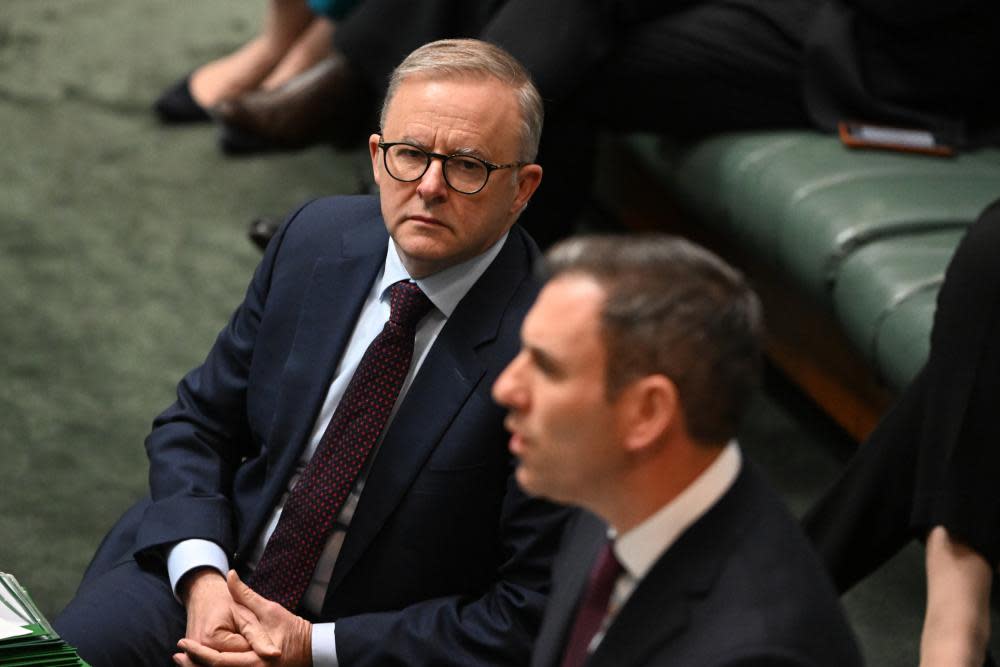Britain’s trickle-down budget idiocy offers a clear lesson for Australia on our stage 3 tax cuts

The current problems with the UK economy provide an indicator of some of the difficulties also facing Australia. But thankfully the UK government has given Anthony Albanese a clear lesson on what not to do.
It is rare to see such a blatant ripping away of the curtain to expose a fraudulent economic theory as we have seen this week. The British prime minister, Liz Truss, spoke last week to the UN general assembly of the glories of trickle-down economics, and told reporters that “lower taxes lead to economic growth, there is no doubt in my mind about that”.
As the old line goes, I could tell you a joke about trickle-down economics but 99% of you won’t get it. Unfortunately for everyone living in the UK, Truss was not joking.
Related: Pound’s plummet underlines schoolboy error by Kwasi Kwarteng
They might not all get the benefits of high-income tax cuts, but everyone in Britain right now is feeling the impact of the UK mini-budget, which scrapped the 45% top tier tax rate for those earning over £150,000 a year, and lowered it to 40% for everyone earning over £50,270.
If that sounds suspiciously like what the stage 3 tax cuts are here in Australia, you are correct – except ours are worse.
The tax cuts in the UK will deliver almost two-thirds of the benefits to the richest 20%; whereas the stage 3 cuts will deliver that group around three-quarters of the benefits.
When investors saw that the Truss government had decided high-end tax cuts are a good idea during a recession with inflation rising fast, they responded with the currency-trading equivalent of “Oh hell no”.
The value of the pound plunged:
If the graph does not display, click here
Currency traders and investors – not the most left-wing of people – quickly saw a government destroying its tax base for no good reason.
There is nothing wrong with a budget deficit – but not if it is just to give money to people who don’t need it.
Deficit spending should build economic capacity – things like childcare, education, infrastructure, investment in renewables, healthcare, government benefits. You know, things that improve society, make it easier to get into work, and increases the productivity of that work.
High-end tax cuts don’t do that.
Sure, conservatives say they do, but only the very obtuse believe it. High-income tax cuts are usually done when things are going well because you can get away pretending they are good for the economy.
You don’t do it when the economy is in the toilet because it reveals that all they do is transfer more of the nation’s income to the very wealthy.
And so the UK is now in a pickle. Inflation is rising fast, and yet the tax cuts, the general idiocy of the mini-budget, and promises of more tax cuts to come has caused the value of the pound to fall, which in turn makes imports more expensive.
Australia and most nations are also dealing with falling currencies, because the US dollar, off the back of its rising interest rates, is very strong.
When rates rise, investing in that currency becomes more attractive (because you get a higher rate of return). As a result, the demand for that currency rises and (like any other good or service) it becomes more expensive.
US interest rates are rising fast – going up by 75 basis points at a time.
If the graph does not display, click here
Other nations – including Australia – are having to go along, because if they don’t, more money will flow from their country to the US, the value of the US dollar will get stronger and the cost of imports in US dollars will rise, leading to more inflation.
This year the value of most currencies has fallen compared to the US dollar:
If the graph does not display, click here
However, this is the good news/bad news of economics. The bad news is imports become more expensive; the good news is our exports are cheaper.
The problem is that manufacturers and other producers here in Australia require imports, and the cost of those imported “inputs” is rising much faster than is the price of imports for we consumers:
If the graph does not display, click here
The other problem is Australia’s currency is actually undervalued at the moment.
Normally when the prices of iron ore and coal are booming, our currency rises in value. This happened back in 2010 when the value of the Australian dollar went above parity with the US dollar.
But since the end of 2020 that link has been busted:
If the graph does not display, click here
The last time the value of our exports was this high was in October 2011. Back then the Australian dollar was worth US$1.05; now it is around US$0.65:
If the graph does not display, click here
That makes our exports cheaper (great if you own an iron ore or coal mine), but not great if you are importing things to make into products.
It also means the prices of petrol, gas and other items that are set by the world market are more expensive than they would have been.
It makes for a tough situation for any government or central bank.
But what the UK has shown very clearly is that the way out is not to believe in the fairy story of trickle-down economics. The stage 3 tax cuts were always the worst policy, but now they are being done at the worst time.
Greg Jericho is a Guardian columnist and policy director at the Centre for Future Work

 Yahoo News
Yahoo News 
